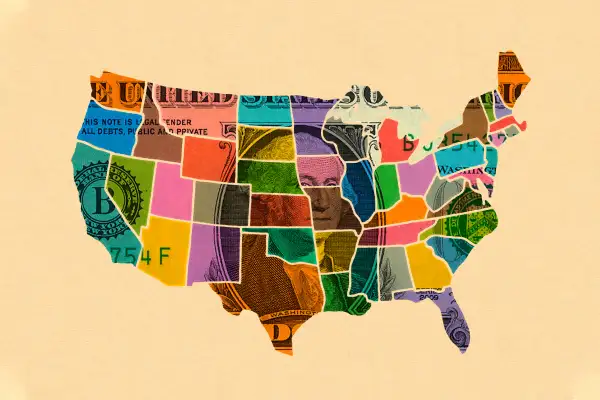Here's a State-by-State Breakdown of PPP Funding — And How Far it Went

Paycheck Protection Program (PPP) funding has been flowing to New York, California, and other states weathering the lion’s share of the Coronavirus outbreaks. But small businesses in those states are having a much harder time accessing that money than other parts of the country.
In large part, the PPP funding directed at each state closely mirrors its population. California, for example, got $66.6 million dollars, while Wyoming got just a little over $1 million, according to data from the Small Business Administration.
Still, Wyoming has less than 70,000 small businesses in the entire state — and about 18% of them received PPP loans. In California, less than 11% of small businesses got PPP funds.
Part of the blame lies on “bank heterogeneity,” or the extent to which banks vary in terms of size, customer base, and ability to be resilient during a crisis, says Christos Makridis, a researcher at the MIT Sloan School of Management.
In major metro areas like New York City, where there seems to be a major bank branch on every corner, many small businesses were left high and dry as banks prioritized applications from companies like Shake Shack and Potbelly. And while community banks doled out much of the funds, that route was a lot easier for small businesses in states like North Dakota—24% of which got approved for PPP loans—than it was for states suffering from the highest infection rates. New York, for its part, only saw 11.15% of its small businesses approved, largely because there are so many of them.
In fact, according to a new study co-authored by Makridis and a team of researchers at MIT and the University of Chicago, the pandemic's hardest-hit states are half as likely to obtain PPP funding compared to other areas.
Small business owners tend to be less knowledgeable on how to navigate the loan processes, and are less likely to have established relationships with major banks, he says.
If you have a working relationship with your bank and some knowledge of how to apply for a loan, you may have gotten through your paperwork faster, and are less likely to get bogged down in the details mid-pandemic. That probably made loan access harder for small businesses run by first-generation immigrant families, and other groups that make up the fabric of large U.S. cities.
Policy makers didn’t have the time to identify the hardest hit regions and research the appropriate amount of money to throw at them," Makridis says. So, “Explicit targeting wasn’t really built in."
In the coming weeks, these discrepancies may greatly affect small business owners’ ability to get back on their feet, rehire, and begin to contribute to a growing U.S. economy again.
Here's a look at which states have received the most and least PPP funding so far, and the percentage of small businesses that got approved for loans in each state, as per SBA data.
The Ten States Getting the Most PPP Funding:
California
$66,635,549,811 to
10.8% of small businesses
Texas
$41,273,591,048 to
11.5% of small businesses
New York
$37,953,606,512 to
11.15% of small businesses
Florida
$30,083,712,148 to
11% of small businesses
Illinois
$22,551,025,846 to
13% of small businesses
Pennsylvania
$21,077,446,319 to
12.8% of small businesses
Ohio
$18,821,736,236 to
12.5% of small businesses
New Jersey
$17,014,757,145 to
12.5% of small businesses
Michigan
$15,947,803,159 to
11.9% of small businesses
Massachusetts
$14,724,135,789 to
14.3% of small businesses
The Ten States Getting the Least PPP Funding:
Wyoming
$1,032,846,961 to
17.8% of small businesses
Vermont
$1,191,982,096 to
13.8% of small businesses
Alaska
$1,260,627,749 to
12% of small businesses
Delaware
$1,456,696,786 to
12.2% of small businesses
South Dakota
$1,649,175,802 to
22% of small businesses
Montana
$1,747,560,402 to
17% of small businesses
North Dakota
$1,778,041,485 to
24% of small businesses
West Virginia
$1,811,401,827 to
13% of small businesses
Rhode Island
$1,886,188,480 to
14% of small businesses
New Mexico
$2,183,201,563 to
11.8% of small businesses
More from Money:
A State-by-State Guide to Getting Pandemic Unemployment Assistance Benefits
What Is a Recession, and Are We in One? Money Asked 3 Economists to Weigh in